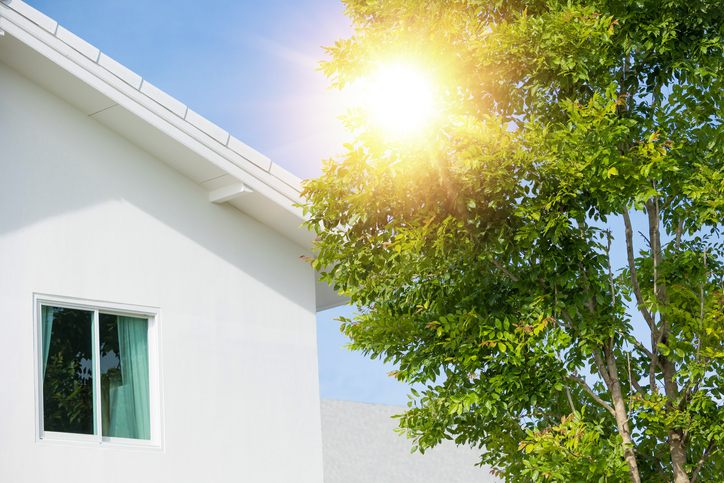Fall is coming, and so are the falling leaves from all of our trees. Are you thinking “UGH – I hate to rake”? Maertin Heating and Cooling has some great news for homeowners to mull as you are raking those dreaded leaves.
Smartly placed and cared-for trees are definitely worth the few weeks of raking. While attractive landscaping can increase the value of your home by 9 to 17%, functional landscaping, landscaping that uses trees and plants to help the house stay cool or warm, can reduce your energy bill by as much as 25%.
According to researchers at Chicago State University, functional landscaping takes advantage of three basic processes. The first and most obvious function is to block the sun and its heat from the home. In our Chicago Southland region, this means providing shade for the south and west sides of the home during the summer.
Secondly – and this one is really amazing – trees actually cool the air around them through a process called evapotranspirational cooling. Basically, as your trees “breathe,” the exchange of gases cools the air around the tree. This cooling effect will make the air around your home slightly cooler and can significantly improve urban “heat islands.”
Finally, functional landscaping can also radically alter the efficiency of our homes by redirecting the air around the dwelling in smart ways. One common example of this kind of landscaping is a windbreak, wind collar or wind wall. This is typically a row of thick evergreen trees planted to block the cold winter wind. Shrewd, thoughtful homeowners and landscapers can even use landscaping to guide breezes into windows to promote better ventilation and circulation year round.
The one real challenge to functional landscaping around Chicago is that our seasons create different energy demands on our homes. That sun we don’t want heating our house in the summer is a real benefit in the winter. Serendipitously, trees have seasons, too. Deciduous trees drop their leaves in the winter, allowing sun to hit your roof and warm your home.
While it’s easy to say that evergreens are great for windbreaks and deciduous trees are great for shading, it’s better to think in greater detail about what kind of trees make sense for your needs. The low-end life span of a tree is 30 years, with some species living thousands of years. That’s a long time to live with a tree you don’t like, or worse, to live with a tree that causes you trouble. In the Midwest, that trouble can be a tree prone to insect infestations or disease like the ash tree, a tree with soft wood such as the cottonwood, a tree with aggressive root structures like lindens, or just a messy tree that’s hard to maintain, such as cottonwood (again) sappy pine trees and weeping willows.
Choose a site and a tree based on the plant’s mature size. For instance, if your tree’s tag says it has a mature spread of 20 feet, you’ll want to plant it at least 10’ away from any permanent structure such as your house or garage.
As you consider what tree will best suit your functional and aesthetic needs, please also consider the needs of the fauna and flora of our region and plant only native and non-invasive plants. The Chicago Botanic Garden has an extensive list of plants and trees that will provide shade and not pose a threat to other plants. Popular trees on that list include various oaks (except the red oak), the Pagoda Dogwood, American Hornbeam, and Ironwood trees. You might also consider a visit to Possibility Place Nursery in Monee, who have experts always happy to help you select a tree that suits your purposes, your lifestyle and your location.
Trees and shrubs can make an enormous difference in the comfort and energy efficiency of your home. Ask the experts to make sure your investment and planting site will work for your home now and for generations to come.




